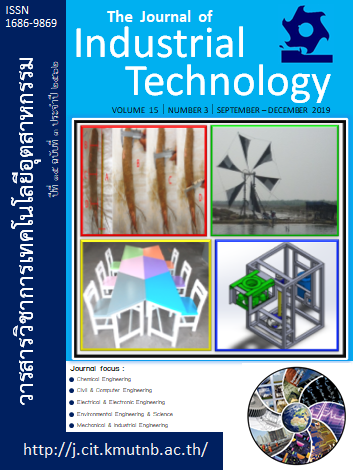(Assessment of Wind Energy Potential in Thailand Based on Using the Multiple-Weibull Distribution)
Keywords:
Monsoon’s effect, Maximum AEO, Multiple-Weibull distribution, Stall-regulated wind turbineAbstract
Abstract
Wind energy potential analysis is a design key to maximize wind turbine efficiency and annual energy output. Typically, the annual wind speed frequency is represented by a Single-Weibull distribution curve in spite of strong and calm wind patterns could occur through a year in many regions in the world, Thailand for instance. For this reason, wind energy potential should be analyzed by Multiple-Weibull distribution curves which are the representative of the meteorological seasons due to the monsoon’s effect. Therefore the objective of this study is to compare the accuracy of the Single-Weibull distribution and the Multiple-Weibull distribution in assessment of wind energy potential. The comparison was made between these two statistical distribution functions and the actual wind speed distribution (measured wind speed frequency) in order to determine the level of credibility of these two distribution functions. The wind speed data employed in this study was measured at Lamtakhong dam site in Nakhon Ratchasima province, Thailand. As the results, the error between the Single-Weibull distribution was 16.46% where the error between the Multiple-Weibull distribution was 14.82%, it was revealed that the smaller error, the higher reliability. Two of the most widely used wind turbines (Enercon E-30 and Windspot) were selected to verify the Multiple-Weibull concept. Approximately 40% increase in annual energy yield by using this method. So, the results confirmed that the Multiple-Weibull distribution is valid for the assessment of the annual energy production of wind turbines. Therefore, this will be a practical method for achieving the optimal design of stall-regulated wind turbine in the further work.
References
[1] D.A. Spera, Wind Turbine Technology: “Fundamental Concepts of Wind Turbine Engineering”, New York: ASME Press, 1994
[2] J. Cartar, P. Ramirez and S. Velazquez, “Influence of the level of fit of a density probability function to wind-speed data on the WECS mean power output estimation” Energy Conversion and Management 2008, 49: 2647-2655
[3] P. Giguère, M.S. Selig and J.L. Tangler, “Blade Design Trade-Offs Using Low-Lift Airfoils for Stall-Regulated HAWTs”, ASME/AIAA Wind Energy Symposium. Nevada, January 11-14, 1999.
[4] W. Sridech and T. Chitsomboon, “Optimal stall-regulated wind turbines in unique local wind statistic”, The 22 nd Conference of Mechanical Engineering Network of Thailand, Bangkok, 2008.
[5] E. Benini and A. Toffolo, “Optimal Design of Horizontal-Axis Wind Turbines Using Blade-Element Theory and Evolutionary Computation”, Journal of Solar Energy Engineering. November, 2002.
[6] C. Thumtae and T. Chitsomboon, “The effect of wind speed and wind statistics skewed on the commercial wind turbine in Thailand”, The
26 th Conference of Mechanical Engineering Network of Thailand, Chiangrai, 2012.
[7] International Electrotechnical Commission, “IEC 61400-1, Ed. 2: Wind Turbine Generator Systems - Part 1: Safety Requirements”, FDIS 1998 -12 -15.


